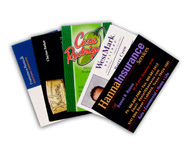Look toward Graph Expo for these eco-friendly inks, low on VOCs and high on marketability.
By Tim Avery -- Graphis Arts Online, 9/1/2007
The bustling exhibits at this month's Graph Expo leave little room for smog-spouting volatile organic compounds (VOCs). Ink manufacturers are exhibiting in full force their eco-friendly products, either free of, or low in, VOCs.
Flint Group (Booth 2226) is showing its recently introduced vegetable-based Novavit F918 Supreme Bio sheetfed ink line. Sold under the K+E premium brand (acquired in Flint's 2005 merger with XSYS), Novavit's vegetable oils emit fewer VOCs, reports the company. Although low-VOC sheetfed inks are generally thought to set more slowly, Flint says its Novavit dries quickly enough to run without set-off, even through a perfector. The company also reports sharp dots, good ink/water balance and high color intensity from the ink, which is said to be especially well suited for glossy-coated papers and boards.
UV ink cures emissionsINX Int'l. (Booth 429) is exhibiting its new Fusion UV hybrid process ink line, which can be run immediately after conventional inks without reconfiguring presses or conditioning rollers. UV ink means reduced VOC emissions, along with drying in only a matter of seconds. Also on display will be the new Ecopure HPJ soy-based sheetfed ink. INX says Ecopure HPJ provides faster set times than its predecessor, Ecopure HP, and its soy base releases fewer VOCs than oil-based counterparts. Early users report lower water settings, with better gray balance and improved trapping. Both Fusion UV hybrid and Ecopure HPJ accept aqueous and UV coatings, as well as overprint varnishes.
Sun Chemical (Booth 2819) is launching Synergy, a package of UV ink, coating, press conditioner, wash and fountain solution chemistries. The company reports Synergy inks can run on hybrid presses when UV-approved hybrid rollers are used.
Formulations are available for sheetfed, web, high-gloss and plastic applications. According to Sun, the high-gloss series does not require UV coating, and Synergy's plastic inks let operators set up jobs on paper to simplify makeready and reduce start-up costs for plastic printing.
Also at Graph Expo is Sun's low-VOC Liberty sheetfed ink line, sold under the Kohl & Madden brand. A PIA/GATF InterTech Technology Award recipient last year, Liberty also does not contain cobalt driers, another potential environmental hazard. The ink is formulated to dry almost instantaneously once printed, yet can stay open on press without drying for days. Sun says Liberty's ability to come up to color quickly and remain stable reduces press waste.
Toyo Ink America (Booth 455) is showing its VOC-free HyPlus 100 premium sheetfed ink, formulated without petroleum-based solvents. Toyo says HyPlus 100 produces strong contrast and high density with low dot gain, and its low water pick-up accelerates makereadies with less emulsification. It reportedly also reduces chalking, gas ghosting and print mottling in folding-carton applications. Other vegetable-based inks from Toyo include HyLite—said to offer great versatility—and HyUnity.
For web presses, Toyo offers soy-based Soya-News ink, which contains a maximum of 0.08 VOC lb./gal. The company says it resists rubbing and scuffing and is formulated to dry quickly.
Van Son Holland Ink (Booth 3470) is introducing its new SonaCure UV-curable, VOC-free inks, which are available in formulations for use on coated or uncoated paper, board stock, foil and plastic substrates, and lacquered or corona-treated surfaces. Van Son says SonaCure offers high gloss and good rub resistance and, though drying quickly under UV light, stays fresh overnight on-press.
taken from www.graphicartsonline.com



 advocacy for the organization throughout the 1960s brought national attention to the organization's mission to bring natural beauty to America's public spaces. As first lady, she was instrumental in convening the White House Conference on Natural Beauty in 1965, and afterward championed the findings through her public support of the Keep America Beautiful organization.
advocacy for the organization throughout the 1960s brought national attention to the organization's mission to bring natural beauty to America's public spaces. As first lady, she was instrumental in convening the White House Conference on Natural Beauty in 1965, and afterward championed the findings through her public support of the Keep America Beautiful organization.



